| Pages:
1
2 |
RabbitTy
Harmless

Posts: 26
Registered: 19-9-2019
Member Is Offline
|
|
grignard reagent to o-Chlorophenyl cyclopentyl ketone
I just cant repeat the ketamine synthesis from Zealot.
The only difference is that I bought Cyclopentyl magnesium bromide 1mol/L in THF instead of synthesizing myself.
Ive tried several times but no target product generated.
CuBr added as catalyst but only made the system more complex without product.
ref also uploaded
could anyone help me out please
Also have few quetions:
1. Dose solvent type crucial to this reaction.I cant get diethyl ether
2. Is there any pratical way to sythesize this product
Attachment: Synthesis of carbon-14 labeled ketamine and norketamine.pdf (640kB)
This file has been downloaded 554 times
|
|
|
Cactuar
Harmless

Posts: 32
Registered: 25-7-2014
Location: Denmark
Member Is Offline
Mood: No Mood
|
|
What's the purity of your nitrile?
Have you triturated your grignard solution?
Explain your procedure. Aromatic nitriles are quite resilient both to the grignard addition and the subsequent hydrolysis.
|
|
|
DavidJR
National Hazard
   
Posts: 908
Registered: 1-1-2018
Location: Scotland
Member Is Offline
Mood: Tired
|
|
I don't think you mean triturated....
|
|
|
RabbitTy
Harmless

Posts: 26
Registered: 19-9-2019
Member Is Offline
|
|
U mean titration?
|
|
|
RabbitTy
Harmless

Posts: 26
Registered: 19-9-2019
Member Is Offline
|
|
Quote: Originally posted by Cactuar  | What's the purity of your nitrile?
Have you triturated your grignard solution?
Explain your procedure. Aromatic nitriles are quite resilient both to the grignard addition and the subsequent hydrolysis. |
I havent confirmed the purity of my meterial.
procedure as follow:
1. Nitrile in THF in the flask under N2.
2. Grignard reagent dropwise to the solution around 0℃。
3. after adding, warm to r.t. then stir for three days.
P.S Ive changed the order of adding but turned out to be se same consequence.
Catalyst CuBr also applied but noithing changed.
|
|
|
monolithic
Hazard to Others
  
Posts: 435
Registered: 5-3-2018
Member Is Offline
Mood: No Mood
|
|
Quote: Originally posted by RabbitTy  | I just cant repeat the ketamine synthesis from Zealot.
The only difference is that I bought Cyclopentyl magnesium bromide 1mol/L in THF instead of synthesizing myself.
Ive tried several times but no target product generated.
CuBr added as catalyst but only made the system more complex without product.
ref also uploaded
could anyone help me out please
Also have few quetions:
1. Dose solvent type crucial to this reaction.I cant get diethyl ether
2. Is there any pratical way to sythesize this product |
I think, in general, dry diethyl ether or THF are necessary for Grignard reagent formation. I believe the same holds true for the Grignard reaction
itself.
| Quote: | | Ethyl ether or THF are essential for Grignard reagent formation. Lone pair electrons from two ether molecules form a complex with the magnesium in the
Grignard reagent (As pictured below). This complex helps stabilize the organometallic and increases its ability to react. |
Source:
https://chem.libretexts.org/Bookshelves/Organic_Chemistry/Supplemental_Modules_(Organic_Chemistry)/Aldehydes_and_Ketones/Synthesis_of_Aldehydes_and_Ke
tones/Grignard_and_Organolithium_Reagents
[Edited on 9-20-2019 by monolithic]
|
|
|
RabbitTy
Harmless

Posts: 26
Registered: 19-9-2019
Member Is Offline
|
|
Quote: Originally posted by monolithic  | Quote: Originally posted by RabbitTy  | I just cant repeat the ketamine synthesis from Zealot.
The only difference is that I bought Cyclopentyl magnesium bromide 1mol/L in THF instead of synthesizing myself.
Ive tried several times but no target product generated.
CuBr added as catalyst but only made the system more complex without product.
ref also uploaded
could anyone help me out please
Also have few quetions:
1. Dose solvent type crucial to this reaction.I cant get diethyl ether
2. Is there any pratical way to sythesize this product |
I think, in general, dry diethyl ether or THF are necessary for Grignard reagent formation. I believe the same holds true for the Grignard reaction
itself.
| Quote: | | Ethyl ether or THF are essential for Grignard reagent formation. Lone pair electrons from two ether molecules form a complex with the magnesium in the
Grignard reagent (As pictured below). This complex helps stabilize the organometallic and increases its ability to react. |
Source:
https://chem.libretexts.org/Bookshelves/Organic_Chemistry/Supplemental_Modules_(Organic_Chemistry)/Aldehydes_and_Ketones/Synthesis_of_Aldehydes_and_Ke
tones/Grignard_and_Organolithium_Reagents
[Edited on 9-20-2019 by monolithic] |
I dried the THF with molecular sieves,however i suppose its not enough right?
|
|
|
draculic acid69
International Hazard
    
Posts: 1371
Registered: 2-8-2018
Member Is Offline
|
|
I read mol.sieves do a much more thorough job of drying than sodium does.
|
|
|
Cactuar
Harmless

Posts: 32
Registered: 25-7-2014
Location: Denmark
Member Is Offline
Mood: No Mood
|
|
Haha, yes, sorry.
Quote: Originally posted by RabbitTy  | I havent confirmed the purity of my meterial.
procedure as follow:
1. Nitrile in THF in the flask under N2.
2. Grignard reagent dropwise to the solution around 0℃。
3. after adding, warm to r.t. then stir for three days.
P.S Ive changed the order of adding but turned out to be se same consequence.
Catalyst CuBr also applied but noithing changed. |
1:1 molar equivalents? I always add the nitrile to the grignard solution and not the other way around. It takes a few minutes to react but then
quickly starts to reflux (ether).
|
|
|
RabbitTy
Harmless

Posts: 26
Registered: 19-9-2019
Member Is Offline
|
|
Quote: Originally posted by Cactuar  |
Haha, yes, sorry.
Quote: Originally posted by RabbitTy  | I havent confirmed the purity of my meterial.
procedure as follow:
1. Nitrile in THF in the flask under N2.
2. Grignard reagent dropwise to the solution around 0℃。
3. after adding, warm to r.t. then stir for three days.
P.S Ive changed the order of adding but turned out to be se same consequence.
Catalyst CuBr also applied but noithing changed. |
1:1 molar equivalents? I always add the nitrile to the grignard solution and not the other way around. It takes a few minutes to react but then
quickly starts to reflux (ether). |
1:1.7 molar equivalents.I cant get ether sadly.I test THF for moist,its around 0.1% which may lead to the failure.
|
|
|
RabbitTy
Harmless

Posts: 26
Registered: 19-9-2019
Member Is Offline
|
|
mol.sieves is better? however Ive tested THF dried by mol.sieves. Moist is around 0.1%.is it too much for grignard reaction?
|
|
|
Prepic
Harmless

Posts: 31
Registered: 23-4-2019
Member Is Offline
|
|
You can always make diethyl ether :
( see https://www.sciencemadness.org/whisper/viewthread.php?tid=97...)
I do believe that THF is preferred over diethy ether however so this shouldnt be an issue. Water, however, is a massive issue with regards to
performing grignard reagents.
I've seen on SM the use of ultrasound to help with grignard reactions in the presence of water and according to other literature ultrasound does
indeed help. Perhaps give ultrasound a try?
Link: https://www.sciencemadness.org/whisper/viewthread.php?tid=65...
|
|
|
monolithic
Hazard to Others
  
Posts: 435
Registered: 5-3-2018
Member Is Offline
Mood: No Mood
|
|
Can you follow the reaction with TLC? I haven't performed a Grignard since undergrad, but shouldn't there be exothermia when you add the Grignard
reagent to your substrate? Do you observe any exothermia, or some other indication of the Grignard reaction taking place?
|
|
|
draculic acid69
International Hazard
    
Posts: 1371
Registered: 2-8-2018
Member Is Offline
|
|
Diethyl ether can be gotten off from starting fluid spray cans.when I was asking round bout grignards is some rxn's happen like 10x better in diethyl
ether than they do in thf.
One person said that one rxn they do ends in 80% in ether but only 10% in thf so it might be worth trying to get ether.available in most car supply
stores.
|
|
|
Pumukli
National Hazard
   
Posts: 686
Registered: 2-3-2014
Location: EU
Member Is Offline
Mood: No Mood
|
|
I would like to second draculic's statement: some Grignards are picky about the solvent! For some THF is better, for some diethyl is the way to go. I
even seen di-n-butil-ether used for some for the greatest yield! There's an article about the solvent effect in these reactions somewhere, of course I
can't find it now - when would be useful. 
|
|
|
Cactuar
Harmless

Posts: 32
Registered: 25-7-2014
Location: Denmark
Member Is Offline
Mood: No Mood
|
|
For your pleasure I just tried the reaction myself but with chlorocyclopropane and m-tolunitrile since I didn't have the other starting materials.
Still a 1M THF solution though. I had to add CuI to get the reaction to start, both for the grignard formation and the alkylation.
Prep:
0.53 Mg turnings (21.8 mmol, 1.1eq) was fused with a small crystal of iodine with a heat gun in a 50mL flat-bottomed RB-flask. 10mL of THF (dried over
mol. sieves) was added and the purple mixture was stirred (pic 1). Chlorocyclopentane (2.08g, 19.89 mmol, 1 eq) was dissolved in 10mL THF and added
dropwise by pipette. After half of it was added and still no reaction had occurred the solution was brought to a boil with a heat gun. The
iodine-color disappeared (pic 2) and the solution became clear but still no sign of the reaction commencing. A very small amount of CuI was added with
the tip of a glass pipette and the reaction started immediately (pic 3). The rest of the chloride was added to keep the mixture refluxing. After it
had finished reacting the whole mixture was again brought to reflux with the help of a heat gun.
m-Tolunitrile (2.25g, 19.20 mmol, 0.97 eq) was dissolved in 5mL THF and was added dropwise by pipette. No reaction occurred even after all the nitrile
had been added. Once again a small amount of CuI was added and the mixture started to violently reflux, almost boiling over (pic 4). After it had
calmed down it was refluxed for 5 minutes and then decanted into 100mL of 1M HCl. The left-over turnings were washed with Et2O 2 times and the
washings decanted into the acid. This was vigorously stirred (pic 5) for 30 minutes and then separated. The aqueos phase was extracted once with Et2O.
The organic phases were combined, dried over MgSO4 and reduced on the rotavap. This gave 3.46g of a golden oil which on TLC (20% EtOAc/pet. Ether)
showed (in descending order) assumed product, starting nitrile, an unknown polar compound and some polymerized stuff that didn't move (pic 6).
The residue was mixed with pet. ether which caused the polymerized stuff to crash out (pic 7). Everything was then ran through a 4 cm silica plug and
the silica eluated with 50mL 20% EtOAc/Pet. ether. This gave a 3.04g of a light yellow oil (pic 8) which was quite pure by TLC (84% yield). A small
band of starting material could still be seen and a faint smell of the nitrile could be noted (pic 9).
---
This was all done in less than two hours with no protecting atmosphere and the nitrile could probably be easily removed by distilling the product. Or
just leave it there. I added 1 eq of bromine neat and stirred for 5 minutes and then reduced it on the rotavap. After adding pet. ether and
evaporating it two times together with the excess bromine and HBr I had an orange oil (pic 10) that crashed out as light yellow crystals upon addition
of methanol. Any nitrile that followed from the previous steps can easily be removed here by filtration. (If the 2'-chloro-bromoketone does
crystallize that is, this is 3'-methyl).
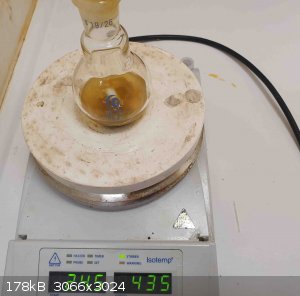 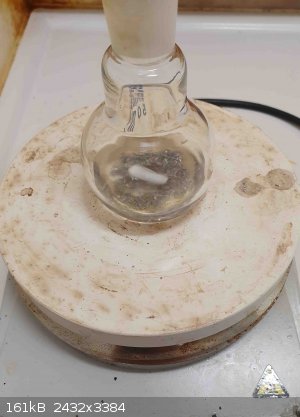 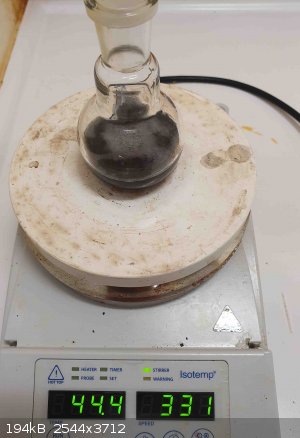 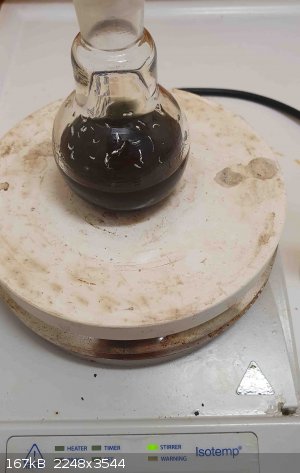 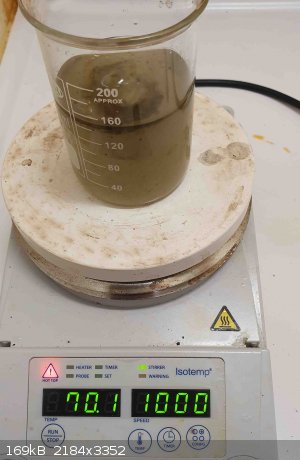 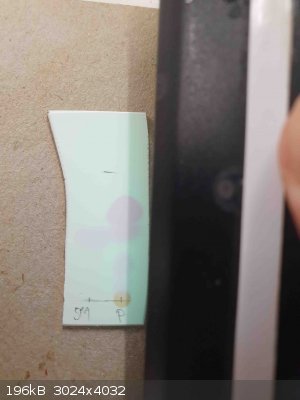 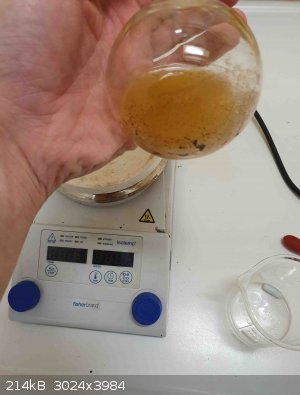 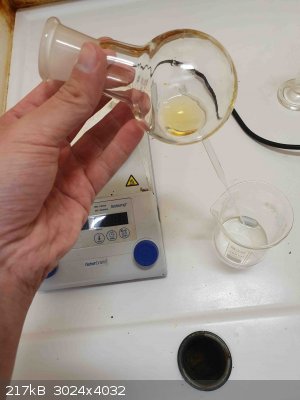 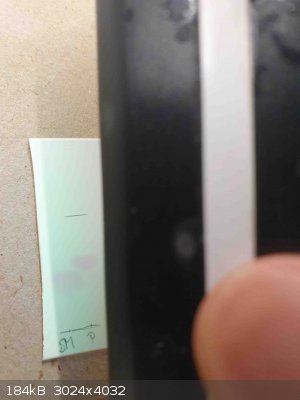 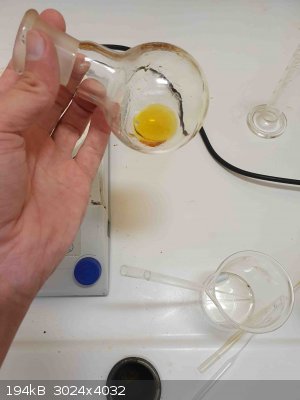
|
|
|
Pumukli
National Hazard
   
Posts: 686
Registered: 2-3-2014
Location: EU
Member Is Offline
Mood: No Mood
|
|
Nice work, Cactuar!
It seems that not the solvent is the culprit, then what?
Maybe the trick is in the CuI what you used? You wrote that this catalyst made the difference between no reaction - almost boiling over.  And was needed both in the Grignard formation and the actual coupling. And was needed both in the Grignard formation and the actual coupling.
Do you have experience with o-substituted nitriles? Don't you think that this subst. pattern may slow down the reaction and make it even harder to
start?
|
|
|
Cactuar
Harmless

Posts: 32
Registered: 25-7-2014
Location: Denmark
Member Is Offline
Mood: No Mood
|
|
Quote: Originally posted by Pumukli  | Nice work, Cactuar!
It seems that not the solvent is the culprit, then what?
Maybe the trick is in the CuI what you used? You wrote that this catalyst made the difference between no reaction - almost boiling over.  And was needed both in the Grignard formation and the actual coupling. And was needed both in the Grignard formation and the actual coupling.
Do you have experience with o-substituted nitriles? Don't you think that this subst. pattern may slow down the reaction and make it even harder to
start? |
Thanks 
I'm quite certain CuBr, which OP used, should be sufficient. And I don't know if it's actually needed, I just got impatient.
No experience from o-substituted nitriles, there's more steric hinderance and also with the chloro, maybe the more electron deficient molecule is even
harder to react. But the paper which OP cites makes it work so it's obviously something else. His procedure seems correct so it's something with the
materials. My guess it's the Grignard solution.
|
|
|
RabbitTy
Harmless

Posts: 26
Registered: 19-9-2019
Member Is Offline
|
|
Quote: Originally posted by monolithic  | | Can you follow the reaction with TLC? I haven't performed a Grignard since undergrad, but shouldn't there be exothermia when you add the Grignard
reagent to your substrate? Do you observe any exothermia, or some other indication of the Grignard reaction taking place? |
When I added the Grignard reagent to the substrate, I observed the exotherm.
TLC shows almost nothing before hydrolysis. After that, few new spot shows but none of them are my pruduct. The reaction have been hydrolyzed by HCl
NH4Cl and H2SO4 separately. however, turned out to be the same consequence.
|
|
|
RabbitTy
Harmless

Posts: 26
Registered: 19-9-2019
Member Is Offline
|
|
Quote: Originally posted by draculic acid69  | Diethyl ether can be gotten off from starting fluid spray cans.when I was asking round bout grignards is some rxn's happen like 10x better in diethyl
ether than they do in thf.
One person said that one rxn they do ends in 80% in ether but only 10% in thf so it might be worth trying to get ether.available in most car supply
stores. |
I googled it and find some reactions do only proceed in ether. Thats important. Thx!
|
|
|
RabbitTy
Harmless

Posts: 26
Registered: 19-9-2019
Member Is Offline
|
|
Quote: Originally posted by Pumukli  | I would like to second draculic's statement: some Grignards are picky about the solvent! For some THF is better, for some diethyl is the way to go. I
even seen di-n-butil-ether used for some for the greatest yield! There's an article about the solvent effect in these reactions somewhere, of course I
can't find it now - when would be useful. 
|
Ive read about it. Different grignard reagents can form different complex with solvent to stabilize it.
|
|
|
RabbitTy
Harmless

Posts: 26
Registered: 19-9-2019
Member Is Offline
|
|
Quote: Originally posted by Cactuar  | For your pleasure I just tried the reaction myself but with chlorocyclopropane and m-tolunitrile since I didn't have the other starting materials.
Still a 1M THF solution though. I had to add CuI to get the reaction to start, both for the grignard formation and the alkylation.
Prep:
0.53 Mg turnings (21.8 mmol, 1.1eq) was fused with a small crystal of iodine with a heat gun in a 50mL flat-bottomed RB-flask. 10mL of THF (dried over
mol. sieves) was added and the purple mixture was stirred (pic 1). Chlorocyclopentane (2.08g, 19.89 mmol, 1 eq) was dissolved in 10mL THF and added
dropwise by pipette. After half of it was added and still no reaction had occurred the solution was brought to a boil with a heat gun. The
iodine-color disappeared (pic 2) and the solution became clear but still no sign of the reaction commencing. A very small amount of CuI was added with
the tip of a glass pipette and the reaction started immediately (pic 3). The rest of the chloride was added to keep the mixture refluxing. After it
had finished reacting the whole mixture was again brought to reflux with the help of a heat gun.
m-Tolunitrile (2.25g, 19.20 mmol, 0.97 eq) was dissolved in 5mL THF and was added dropwise by pipette. No reaction occurred even after all the nitrile
had been added. Once again a small amount of CuI was added and the mixture started to violently reflux, almost boiling over (pic 4). After it had
calmed down it was refluxed for 5 minutes and then decanted into 100mL of 1M HCl. The left-over turnings were washed with Et2O 2 times and the
washings decanted into the acid. This was vigorously stirred (pic 5) for 30 minutes and then separated. The aqueos phase was extracted once with Et2O.
The organic phases were combined, dried over MgSO4 and reduced on the rotavap. This gave 3.46g of a golden oil which on TLC (20% EtOAc/pet. Ether)
showed (in descending order) assumed product, starting nitrile, an unknown polar compound and some polymerized stuff that didn't move (pic 6).
The residue was mixed with pet. ether which caused the polymerized stuff to crash out (pic 7). Everything was then ran through a 4 cm silica plug and
the silica eluated with 50mL 20% EtOAc/Pet. ether. This gave a 3.04g of a light yellow oil (pic 8) which was quite pure by TLC (84% yield). A small
band of starting material could still be seen and a faint smell of the nitrile could be noted (pic 9).
---
This was all done in less than two hours with no protecting atmosphere and the nitrile could probably be easily removed by distilling the product. Or
just leave it there. I added 1 eq of bromine neat and stirred for 5 minutes and then reduced it on the rotavap. After adding pet. ether and
evaporating it two times together with the excess bromine and HBr I had an orange oil (pic 10) that crashed out as light yellow crystals upon addition
of methanol. Any nitrile that followed from the previous steps can easily be removed here by filtration. (If the 2'-chloro-bromoketone does
crystallize that is, this is 3'-methyl).
|
Nice work!Thx!
Ive tried both with or without CuBr in my reactions. When CuBr applied, the reaction time reduced to near 20hours. It took almost 3 days without the
CuBr.I guess the o-sub make the reaction more difficult to proceed. On the other hand, analysis the moist of th solvent showd its contain near 0.1%
moist in the THF , I wonder is there any standard of the moist in the solvent used in grignard reaction.
|
|
|
RabbitTy
Harmless

Posts: 26
Registered: 19-9-2019
Member Is Offline
|
|
Quote: Originally posted by Cactuar  | For your pleasure I just tried the reaction myself but with chlorocyclopropane and m-tolunitrile since I didn't have the other starting materials.
Still a 1M THF solution though. I had to add CuI to get the reaction to start, both for the grignard formation and the alkylation.
Prep:
0.53 Mg turnings (21.8 mmol, 1.1eq) was fused with a small crystal of iodine with a heat gun in a 50mL flat-bottomed RB-flask. 10mL of THF (dried over
mol. sieves) was added and the purple mixture was stirred (pic 1). Chlorocyclopentane (2.08g, 19.89 mmol, 1 eq) was dissolved in 10mL THF and added
dropwise by pipette. After half of it was added and still no reaction had occurred the solution was brought to a boil with a heat gun. The
iodine-color disappeared (pic 2) and the solution became clear but still no sign of the reaction commencing. A very small amount of CuI was added with
the tip of a glass pipette and the reaction started immediately (pic 3). The rest of the chloride was added to keep the mixture refluxing. After it
had finished reacting the whole mixture was again brought to reflux with the help of a heat gun.
m-Tolunitrile (2.25g, 19.20 mmol, 0.97 eq) was dissolved in 5mL THF and was added dropwise by pipette. No reaction occurred even after all the nitrile
had been added. Once again a small amount of CuI was added and the mixture started to violently reflux, almost boiling over (pic 4). After it had
calmed down it was refluxed for 5 minutes and then decanted into 100mL of 1M HCl. The left-over turnings were washed with Et2O 2 times and the
washings decanted into the acid. This was vigorously stirred (pic 5) for 30 minutes and then separated. The aqueos phase was extracted once with Et2O.
The organic phases were combined, dried over MgSO4 and reduced on the rotavap. This gave 3.46g of a golden oil which on TLC (20% EtOAc/pet. Ether)
showed (in descending order) assumed product, starting nitrile, an unknown polar compound and some polymerized stuff that didn't move (pic 6).
The residue was mixed with pet. ether which caused the polymerized stuff to crash out (pic 7). Everything was then ran through a 4 cm silica plug and
the silica eluated with 50mL 20% EtOAc/Pet. ether. This gave a 3.04g of a light yellow oil (pic 8) which was quite pure by TLC (84% yield). A small
band of starting material could still be seen and a faint smell of the nitrile could be noted (pic 9).
---
This was all done in less than two hours with no protecting atmosphere and the nitrile could probably be easily removed by distilling the product. Or
just leave it there. I added 1 eq of bromine neat and stirred for 5 minutes and then reduced it on the rotavap. After adding pet. ether and
evaporating it two times together with the excess bromine and HBr I had an orange oil (pic 10) that crashed out as light yellow crystals upon addition
of methanol. Any nitrile that followed from the previous steps can easily be removed here by filtration. (If the 2'-chloro-bromoketone does
crystallize that is, this is 3'-methyl).
|
furthermore, I can also get the top spot compound on TLC after hydrlyzing. However, it turned out they arent my product after analyzing by LC-MS. I
wonder didu confirm the structure of ur product.
|
|
|
Cactuar
Harmless

Posts: 32
Registered: 25-7-2014
Location: Denmark
Member Is Offline
Mood: No Mood
|
|
Quote: Originally posted by RabbitTy  | | furthermore, I can also get the top spot compound on TLC after hydrlyzing. However, it turned out they arent my product after analyzing by LC-MS. I
wonder didu confirm the structure of ur product. |
I never did. But it did brominate, form an imine, reacted with HCl in iPrOH and rearranged in benzyl acetate. I'm recrystallizing it right now but
have no intention of tasting it.
What did your LC/MS say?
|
|
|
RabbitTy
Harmless

Posts: 26
Registered: 19-9-2019
Member Is Offline
|
|
Quote: Originally posted by Cactuar  | Quote: Originally posted by RabbitTy  | | furthermore, I can also get the top spot compound on TLC after hydrlyzing. However, it turned out they arent my product after analyzing by LC-MS. I
wonder didu confirm the structure of ur product. |
I never did. But it did brominate, form an imine, reacted with HCl in iPrOH and rearranged in benzyl acetate. I'm recrystallizing it right now but
have no intention of tasting it.
What did your LC/MS say? |
TLC(20%etoac/pet ether),the top spot like ur. I purified by column chromatography.However LC-MS showed more than one compound in it.After that i
changed to 2%EtOAc/Pet ether. And it shows three spots instead.
LC-MS file been loaded
Attachment: JLX1904-SM3-19090201.PDF (45kB)
This file has been downloaded 316 times
|
|
|
| Pages:
1
2 |